“I apologize for not getting back to you earlier, had a lot on my plate,” is one of the most eye-roll-inducing email replies that, unfortunately, are pretty common. Even though this statement says that the receiver has been crazed and didn’t have any time to read what you sent them, what it really says is:
“I saw your email. I read it but I wasn’t interested in replying as soon as possible. There were some other people waiting for responses, so I chose to get back to them first.”
In my experience, I have had my fair share of emails with similar responses, and they frustrated me a little bit. A person who says they were too busy to reply to my email is typically switches between multiple communication channels - throw Messenger, LinkedIn, and other sites there - so they choose to prioritize their time and respond selectively.
Or it’s also possible that they receive so many poor emails that they simply forget about yours. For example, even Sir Richard Branson has this problem, as he once tweeted this, implying that some of the messages he receives are awful.
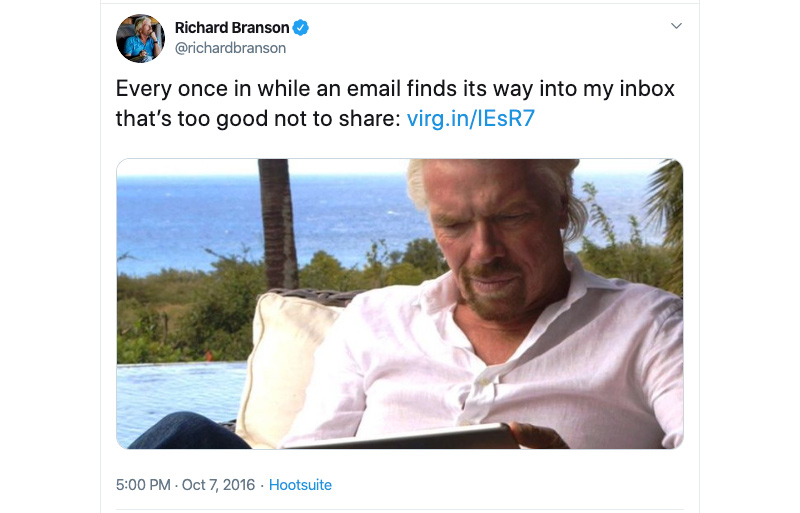
But what if you could write emails that people would want to put on top of their “response” list? Regardless of what you’re writing about, you can communicate much better than other people, and get your answers in the shortest possible time frames.
In this guide, we’re going to show you what it takes to achieve that.
1. Write Interesting Subject Lines
A subject line is the first thing that the receiver sees when your message arrives in their inbox, so it has to be good enough to:
- to make the receiver notice it in their overfilled inbox
- to convince them to open the message and read the content.
Clearly, this makes writing an engaging subject line a critical requirement for a great email, so don’t underestimate its importance for getting your messages opened and read. In fact, according to SuperOffice study, a subject line is the reason why 47 percent of people open email messages.
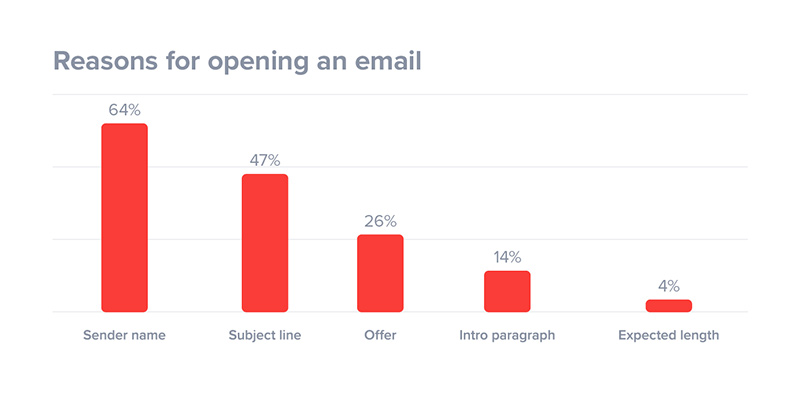
Credit: SuperOffice
So, how to make sure that your subject lines are well-crafted and meet the above requirements? Consider the following tips.
- Avoid spammy and salesy lines that make ridiculous promises, e.g. “Open this message and win $1,000.” People are sick and tired of in-your-face advertising and hard sell, so writing email messages this way has become a sure-fire way to get them to the spam folder
- Avoid vague and unclear statements. For example, I’ve recently received a message with “Quick Question” as a headline. Well, if the sender wants to ask a quick question, why not do it in the subject line? Instead, what they ended up was a pretty useful subject line
- Make it short and sweet. According to the abovementioned Super Office survey, the open rate is the highest for subject lines containing between 6 and 10 words
- Personalize it. Include the name of the recipient if possible; studies suggest that it could increase the open rate by as much as 20 percent
- Describe the benefits of opening the message, e.g. “Read this message to know the common SEO mistakes”
- Let the recipient know what’s inside the message. For example, if you’re writing to make a cooperation request, then do tell the recipient about it
- Ask the recipient a question, e.g. “Are you interested in seeing the best blogging courses?”
2. Use the Classic Style for the Body
Now that you have some ideas on how to write an engaging subject line, let’s focus our attention on the body of the email. Even though there are many ways to write it, let’s talk about the classic style with an intro, a body, and a conclusion.
Writing an email using the essay style is a good idea because it provides a logical flow of information and a structure. Each of the three sections shouldn’t be long but provide the reader with enough information for them to have a good idea of what you’re trying to tell them.
Let’s now talk about the sections in more detail.
Writing The Introduction
There are multiple ways to begin your letter, and the best one to use depends on the goal of your email. For example, if you’re writing a business email to a potential partner, CEO, investor, or someone on an executive-level position, you should introduce yourself, your business and your offer in the first sentence.
Why? Because business people receive lots of emails - in fact, there were about 281 billion business emails sent and received in 2018 - so you have to make your goal clear from the start.
The first thing is the greeting. Regardless of the length and purpose of the email, always greet the recipient by name if possible. However, note that the greeting depends on the recipient’s position and the type of email. For example, if you’re writing a business email, it’s better to write a formal greeting that involves using last names and titles.
On the other hand, if you’re writing to someone you know or just a friendly letter to a customer, it’s appropriate to use informal greetings, e.g. “Dear Sara,” “Hi Anthony,” etc. Always try to find out the position or the name of the person you’re writing to, as beginning your letter with “To whom it may concern” is impersonal and quickly becoming an outdated practice.
Here’s an example that comes from a well-known personal finance advisor Ramit Sethi. He explains his offer in the first sentence so the recipient understands what the message is all about right away.
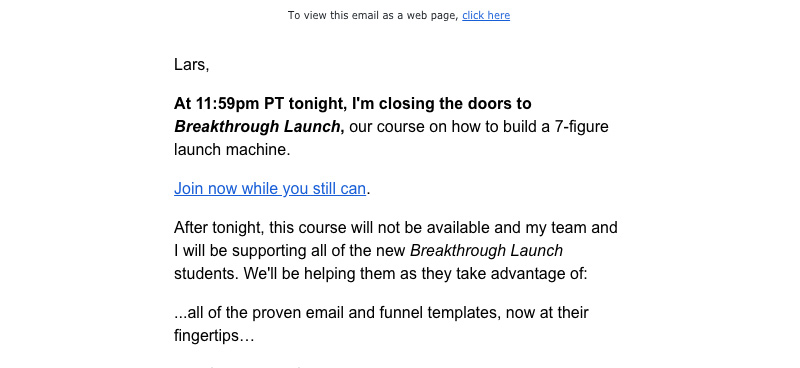
Source: Screenshot
Another way to begin your message is to grab the attention of the reader with a fact that can potentially be interesting to them (this technique is often used by email marketers to improve the conversion rate). For example, here’s an example from the Digital Marketing Institute where the writer is using a stat that can be interesting to the target audience of the company.
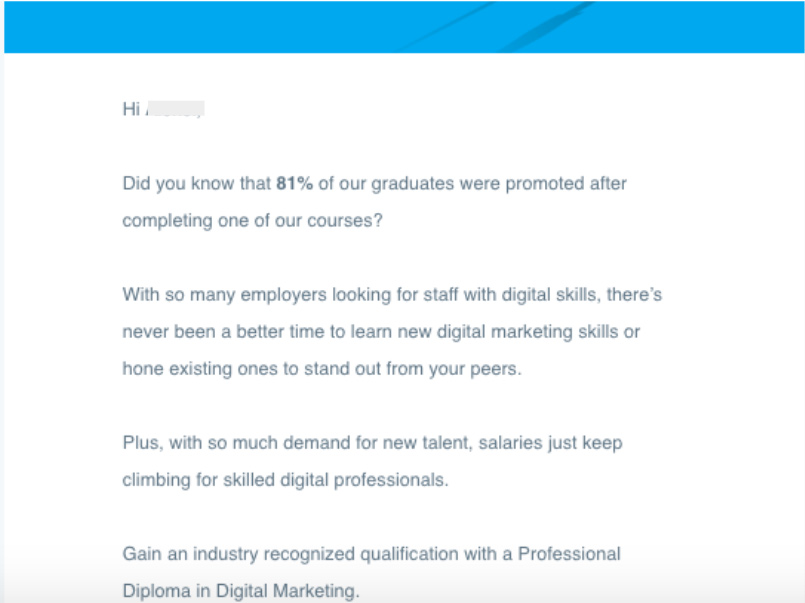
Source: Screenshot
Indeed, citing such a stat could grab the attention of people looking for a reliable provider of online education, so this technique is definitely worth consideration for customer emails.
Writing The Body
This is where you explain the purpose of the email in more detail. To make it work, make sure that you’ve given the readers enough information so they could take the action you want them to take. This information may include dates, deadlines, guidelines, descriptions of offers and products, and other contextual details, and should be represented in a logical way.
To increase the chance of the reader taking the desired action, provide them with a concise explanation and reasoning why they should do it. For example, take a look at this email from CoSchedule. The writer described the benefits of reading their content in a concise manner (and even thrown a mention of the tool being nominated for an award, which also works for encouraging the reader to read).
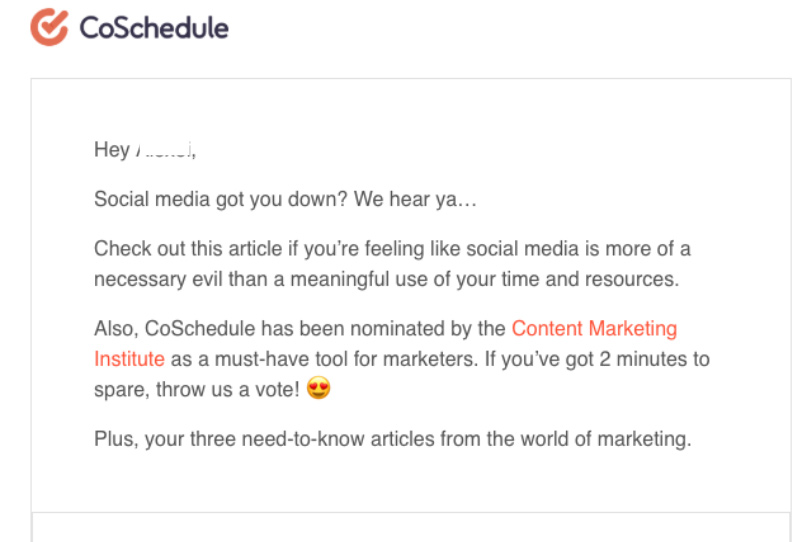
Source: Screenshot
As you can see, the body is very concise and fluff-free, which is a good technique because it increases the chance that the recipients will read it. Besides, keep in mind that it’s really easy and scan the text and not miss any important information if you use bulleted lists, short sentences, and line breaks.
The next important thing about the example above that it doesn’t feature ornate, too colorful, or playful fonts. Using them is not recommended because they can easily distract the reader from the main message or even prevent them from treating the letter seriously.
If you can’t make your email as concise as this one because it requires more details, your best bet is to keep it focused as possible. Remember, no one wants - and has the time - to read novels. In addition to your messages, you can also use Gmail notes as a reminder for yourself. These are especially useful if you have an excess of information that needs mentioning in the message but do not want it cluttering up your email threads with confusion.
Important! Always consider cultural differences when writing the letter. For example, if the recipient’s first language is not English, try to compose your message in simple language.
Also, be very careful about using humor. If you feel like you need to have something humorous, keep in mind that what’s funny to you might not be funny to a person from a different culture. Moreover, there’s a big difference between written and spoken humor, as it’s much easier to misunderstand the meaning of a written message. That’s why in most cases, the use of humor is not recommended.
Writing The Conclusion
A great way to close the email is to make a statement that makes the message clear and lets the recipient know what to do next. This is often called “call to action,” or CTA, and you could try different versions of them in your emails.
For example, one version is a textual CTA, and it’s appropriate for personal and business emails. The below email comes from Impact and it also a link embedded to make it easier for the recipient to complete the desired action.

Source: Screenshot
If you’re writing a business email and a textual CTA without the link, consider these two examples to improve it:
Basic CTA:
Please let me know if you have any questions.
Great CTA:
“Please take a look at pages 10-11 of the attached report and let me know before our SCRUM meeting on Tuesday if you have any suggestions or comments.”
Another way to end an email is to design a CTA button to focus the attention of the recipient. This technique is common in consumer emails that try to direct the recipients to a sender’s website or specific landing pages. For example, here’s an email from the abovementioned Ramit Sethi that uses a CTA button.
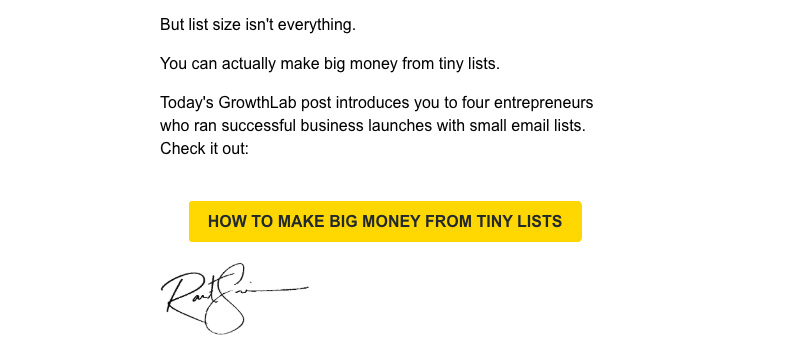
Source: Screenshot
Writing a call-to-action for the button as well as designing it also requires you to follow some rules. For example, to focus the attention of the recipient on the button, it should have a contrasting color to stand out from the rest of the content. Also, the text of the CTA button has to be action-oriented to entice the reader to click on it.
Now that we’ve reviewed how to write the body of the letter, there’s one more consideration left: editing. Just imagine that your letter with silly grammar or punctuation mistakes is sent to a CEO or another executive-level position. Even though composing an email is pretty quick, they can leave a long-lasting impression, and it shouldn’t be a negative one.
That’s why checking out editing services reviews and selecting a reliable editor to take a look at your letter is often recommended. The process will take less than an hour but you can significantly improve the clarity and logical flow of information in your letter, as well as help you avoid silly mistakes.
3. Writing a Sign-Off and Signaturey
While there are many ways to end an email, the proper one depends on the nature of the message. For example, if you’re writing a formal letter, you shouldn’t be too creative and choose among the most common sign-offs such as:
- Warms regards,
- Yours truly,
- Kind regards,
- Regards,
- Best regards,
- Respectfully,
- Thanks,
- Sincerely.
On the other hand, the ones that you should never use include (along with explanations why):
- I’m looking forward to your reply (sounds a bit passive-aggressive)
- Tnx (what are you, twelve?)
- Take care (is it to imply that the danger is coming?)
- [no sign-off] (this is simply impolite).
The last important element of an email is the signature. Unfortunately, many people disregard the importance of having a detailed signature, which is a big mistake, especially in the case of business emails. For example, by failing to include a signature with multiple contact options, you’re reducing the chances that the recipient will answer.
So, the signature depends on the nature of the email, too, so let’s consider the most common options so you know which one is appropriate for different occasions.
First, a business email may include a typical formal signature that includes the following:
- Your full name
- Your position and company
- Your contact information (email, phone, LinkedIn profile, etc.)
- A link to your company’s or personal website or any other relevant web pages
- Your headshot (if appropriate).
Let’s see some examples. The first one comes from the Impact, and it features some of the above points.

Source: Screenshot
As you can see, the signature includes essential information about the sender and doesn’t look cluttered, which is always something to keep in mind.
Another way that has been increasing in popularity in recent years is featuring the image of the real signature. We’ve already seen one example with a real signature from Samit Rethi above, but here’s one more. This time, it comes from Yes Marketing.

Source: Screenshot
The sender also used the opportunity to include some links to her website, which is also a good idea if the recipient of the email is a customer.
Entrepreneurs are also increasingly using the links to social media profiles in their signatures to make it easier for recipients to contact them. For example, here’s how a yoga teacher does this.
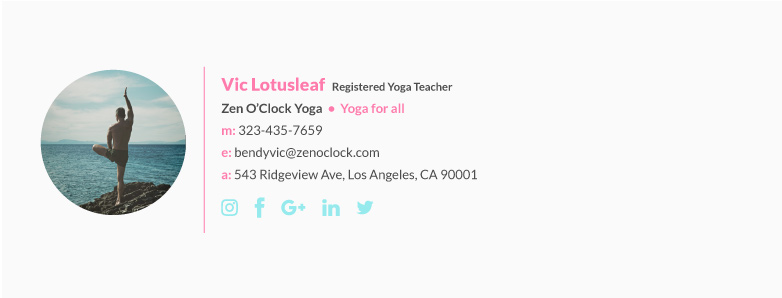
Source: Screenshot
There are also many mistakes to be made when writing an email signature. They include:
- Using multiple fonts. It may make the text difficult to read or distract the recipient; besides, some fonts may also make you look unprofessional. If you feel like you need to differentiate something, it’s better to play around with font size and weight.
- Including inspirational quotes. The only thing that they’ll do is take up the precious space, as people don’t typically care about reading quotes in email signatures
- Including jokes and memes. This is plain childish and can make you look unprofessional
- Making the entire signature an image. While inserting your photo is a good practice, making the entire signature an image is a risky decision because it may not always display properly and doesn’t allow the recipient to copy your contacts
- Failing to design a mobile-friendly signature. Some people prefer to include a lot of elements into one signature - text, images, links, etc. - but they forget that they might not be displayed well on a mobile screen. Doing so is a bad idea because 40 percent of people aged between 18 and 40 always open emails on a mobile device, according to Email Monday.
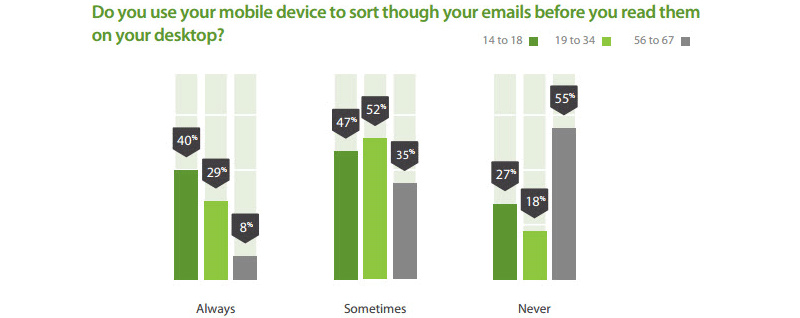
Source: Email Monday
By writing an email signature and avoiding these mistakes, you’re showing the recipients who you are and how to contact you, which is really professional.
Final Thoughts
Now that you know how to write better emails, one thing needs to be stressed one more time: proofreading. Once you’ve sent an email, there’s no going back (well, to be completely correct, Gmail allows us to undo it but only within a very short time window), so checking the text one again is always a good idea. It’s easy to miss a silly mistake while writing, but the recipient will notice that, so you’ll miss the chance to make a good first impression.
So, it’s over to you now, follow the best practices that I’ve described and you’ll increase the chance of people responding to your messages (plus Richard Branson won’t tweet about how unworthy of sharing they are). Good luck!
About the author:
Daniela McVicker is a blogger and a freelance writer who works closely with B2B and B2C businesses providing blog writing, copywriting and ghostwriting services. Currently, she contributes to RatedbyStudents. When Daniela isn’t writing, she loves to travel, read romance and science fiction, and try new wines.
What would you like to know and what would be the best way to share this information to you? What is the best tips & tricks, what workaround do you use? We'd really appreciate your insight on these ones to make our integrations better, more productive and much more efficient. Comments, tweets are always welcome.